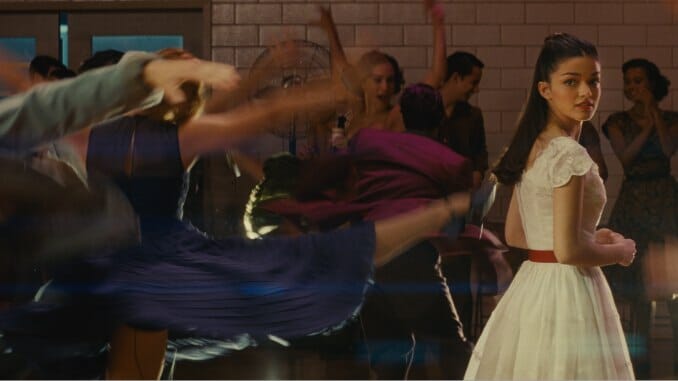Steven Spielberg Will Make You Love West Side Story All Over Again

Shoot it loud and there’s music playing; shoot it soft and it’s almost like praying: Steven Spielberg’s West Side Story pumps the classic for exactly that, classicism, by milking the musical’s dynamics for maximum expressiveness. Its romance? At its most tender. Its dance? At its most invigorating and desperate. Its songs? As if “Maria” or “Tonight” needed another reason to stick in your head, they’re catchier than ever. Even if you don’t know the lyrics, you know the snaps. And you won’t even need that level of familiarity to get swept up. Spielberg’s been working up to a full-throated musical for decades and he comes at this movie like he’s got something to prove: If there was ever any doubt that he’s a cinematic peer to Leonard Bernstein and Stephen Sondheim, West Side Story sets it firmly aside. It’s a stunning, loving spectacle that confidently scales the fence right to the top of the movie-musical pack.
You might know the story: The Romeo and Juliet affair between white Tony (Ansel Elgort) and Puerto Rican Maria (Rachel Zegler) drowning in the posturing power struggle between the Jets and Sharks—ethnic street gangs respectively led by their best friend and brother. They meet at a dance, but alas, a rumble is coming. And in America, in New York City, there’s always a rumble coming for their lot. Conspicuously placed inside a deteriorating New York, where buildings are demolished for the good of nebulous and unseen Richie Riches and corrupt civil servants, it’s as much a story about the various responses to capital-driven oppression (buying into the mystical promise of bootstrapping hard work, raging against various machines, saying “fuck it” and blaming another race) as it is about love or hate. Everyone’s emotions are running hot—even hotter than you’d expect in a musical—because everyone’s living on the brink. They don’t got a lot and even what they got they don’t actually have. So in this desperate, frustrating, ultimately futile turf war over ruins and rubble, they’re gonna fight, kiss and (most of all) dance it out while they still can.
Justin Peck, choreographer of the New York City Ballet, highlights this simmering physical threat and sexual power (not mutually exclusive among the charged dancers) by making the most of his performers’ long limbs and extravagant costumes. Bright dress ruffles and beefy arms twirl in magical, powerful symmetry. Spielberg, in turn, stages the numbers to fully explore the space (when sparring in the salt warehouse or on the dance floor) or lack thereof (when melting hearts in Tony and Maria’s fire-escape rendezvous). Nearly every shot is foregrounded with impediments, be they chain-link fences keeping the boys trapped in their circumstances, onlookers framing spotlit dancers, or wrought iron grating separating lovers. It’s a city, after all. Cluttered. Messy. Full of people, things—and potential. Attraction. Camaraderie. Respect. Encapsulated in stand-offs and close-up faces. These are shots that already look like classics, not because they mimic the 1961 film (though Spielberg’s clearly a fan and nods its way in a few key moments), but because they look like they were dreamed, planned and pulled off. You can feel the achievement, yet there’s nothing stagey here: The film’s two-and-a-half hours either zip along or linger so closely around the campfire glow of its couple’s radiating affection that you’d happily stay with them all night.
It’s even more impressive because the movie partially hamstrung itself in the casting phase. Someone teach Ansel Elgort how to cry, or at least how to feel something. In a movie of red-hot, rampant, capital-E Emotions, Elgort’s Tony is a large piece of attractive furniture that never even manages to creak the same way twice. The doe-eyed, soft-faced, semi-accented giant offers ample romantic scaffolding for the tiny Rachel Zegler to duck under and lean against, and his earnest voice is winningly wavering, but his muddy performance is an obstacle. Zegler, however…Zegler’s the real deal. Almost cartoonishly beautiful and with a voice like crystal, she’s also twice the actor of her foil. Witty and sharp—naturally in “I Feel Pretty” but even when navigating the kid/adult flux of her teen bedroom—she’s magnetic in movement and line deliveries. She can either dominate the screen or simply allow it to appreciate her. She’s a movie star.